HOSP 213: Hospitality Industry Assessment 1 - Short Answer Questions
VerifiedAdded on 2023/05/30
|12
|2171
|242
Homework Assignment
AI Summary
This assessment delves into various facets of the hospitality industry, beginning with an examination of industry quality assurance processes and identifying the benefits of accreditation schemes for an organization. It then explores the roles and responsibilities within an accreditation scheme and the consequences of non-compliance. The assignment further investigates industry bodies and associations, outlining the information obtainable from each. A significant portion is dedicated to the kitchen brigade hierarchy, job duties, and inter-team relationships. The assessment also covers legislation affecting the workplace, methods to enhance work performance, and requirements for food safety and alcohol service. Additionally, it explores opportunities to update knowledge, current industry issues, the role of trade unions, and accessing information on equal employment opportunity. The assignment concludes with a review of problem-solving skills and their importance within the industry.
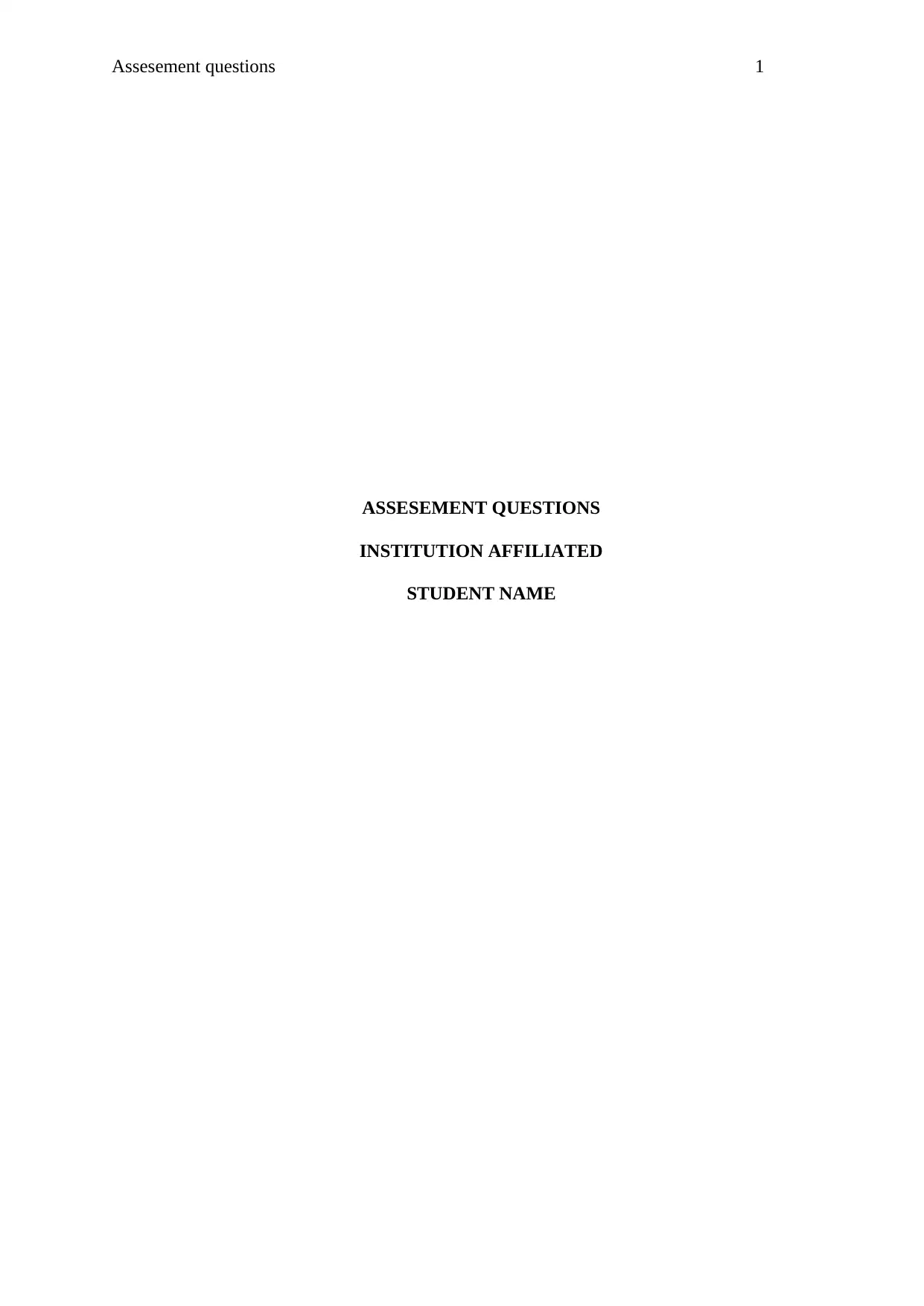
Assesement questions 1
ASSESEMENT QUESTIONS
INSTITUTION AFFILIATED
STUDENT NAME
ASSESEMENT QUESTIONS
INSTITUTION AFFILIATED
STUDENT NAME
Paraphrase This Document
Need a fresh take? Get an instant paraphrase of this document with our AI Paraphraser
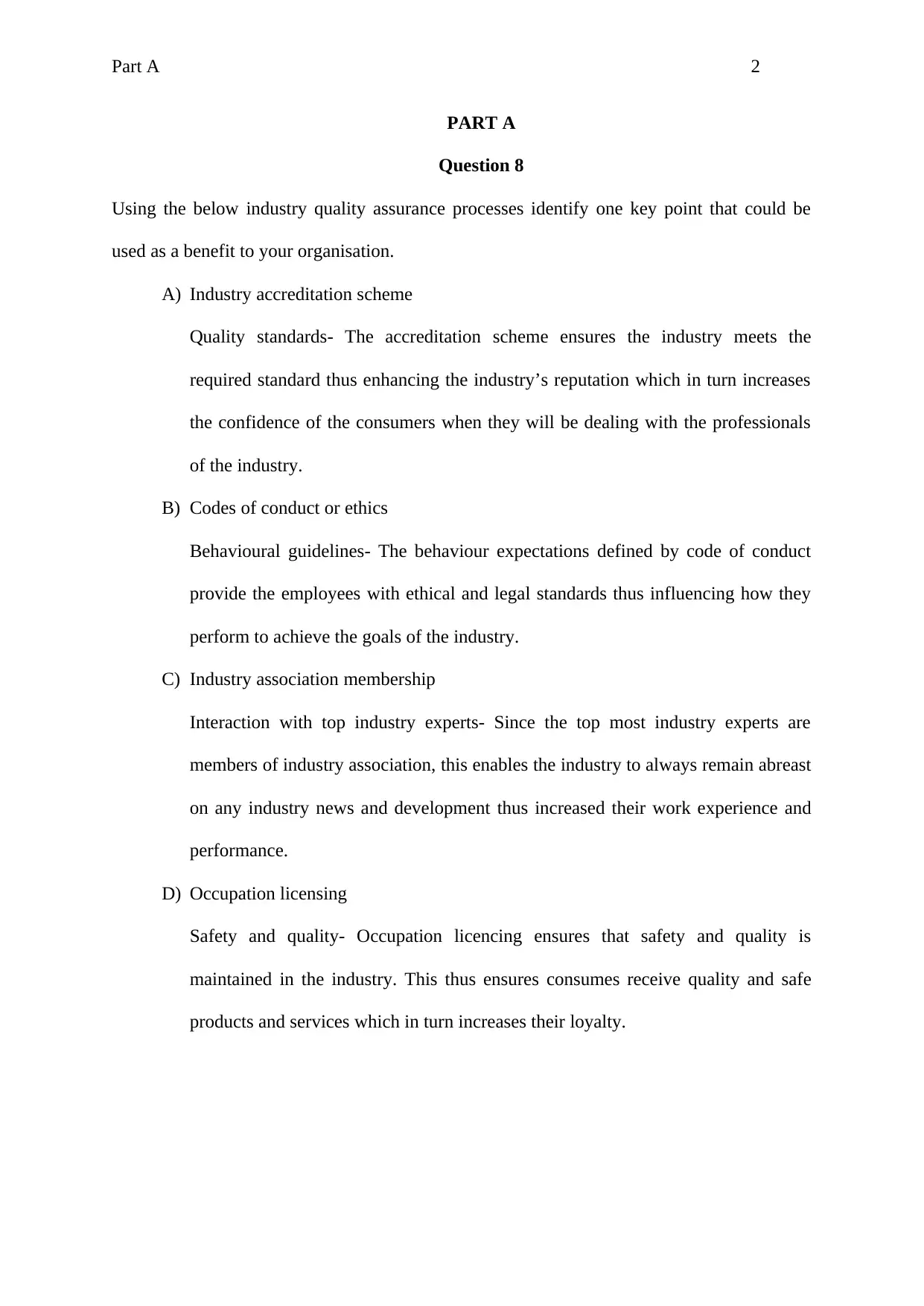
Part A 2
PART A
Question 8
Using the below industry quality assurance processes identify one key point that could be
used as a benefit to your organisation.
A) Industry accreditation scheme
Quality standards- The accreditation scheme ensures the industry meets the
required standard thus enhancing the industry’s reputation which in turn increases
the confidence of the consumers when they will be dealing with the professionals
of the industry.
B) Codes of conduct or ethics
Behavioural guidelines- The behaviour expectations defined by code of conduct
provide the employees with ethical and legal standards thus influencing how they
perform to achieve the goals of the industry.
C) Industry association membership
Interaction with top industry experts- Since the top most industry experts are
members of industry association, this enables the industry to always remain abreast
on any industry news and development thus increased their work experience and
performance.
D) Occupation licensing
Safety and quality- Occupation licencing ensures that safety and quality is
maintained in the industry. This thus ensures consumes receive quality and safe
products and services which in turn increases their loyalty.
PART A
Question 8
Using the below industry quality assurance processes identify one key point that could be
used as a benefit to your organisation.
A) Industry accreditation scheme
Quality standards- The accreditation scheme ensures the industry meets the
required standard thus enhancing the industry’s reputation which in turn increases
the confidence of the consumers when they will be dealing with the professionals
of the industry.
B) Codes of conduct or ethics
Behavioural guidelines- The behaviour expectations defined by code of conduct
provide the employees with ethical and legal standards thus influencing how they
perform to achieve the goals of the industry.
C) Industry association membership
Interaction with top industry experts- Since the top most industry experts are
members of industry association, this enables the industry to always remain abreast
on any industry news and development thus increased their work experience and
performance.
D) Occupation licensing
Safety and quality- Occupation licencing ensures that safety and quality is
maintained in the industry. This thus ensures consumes receive quality and safe
products and services which in turn increases their loyalty.
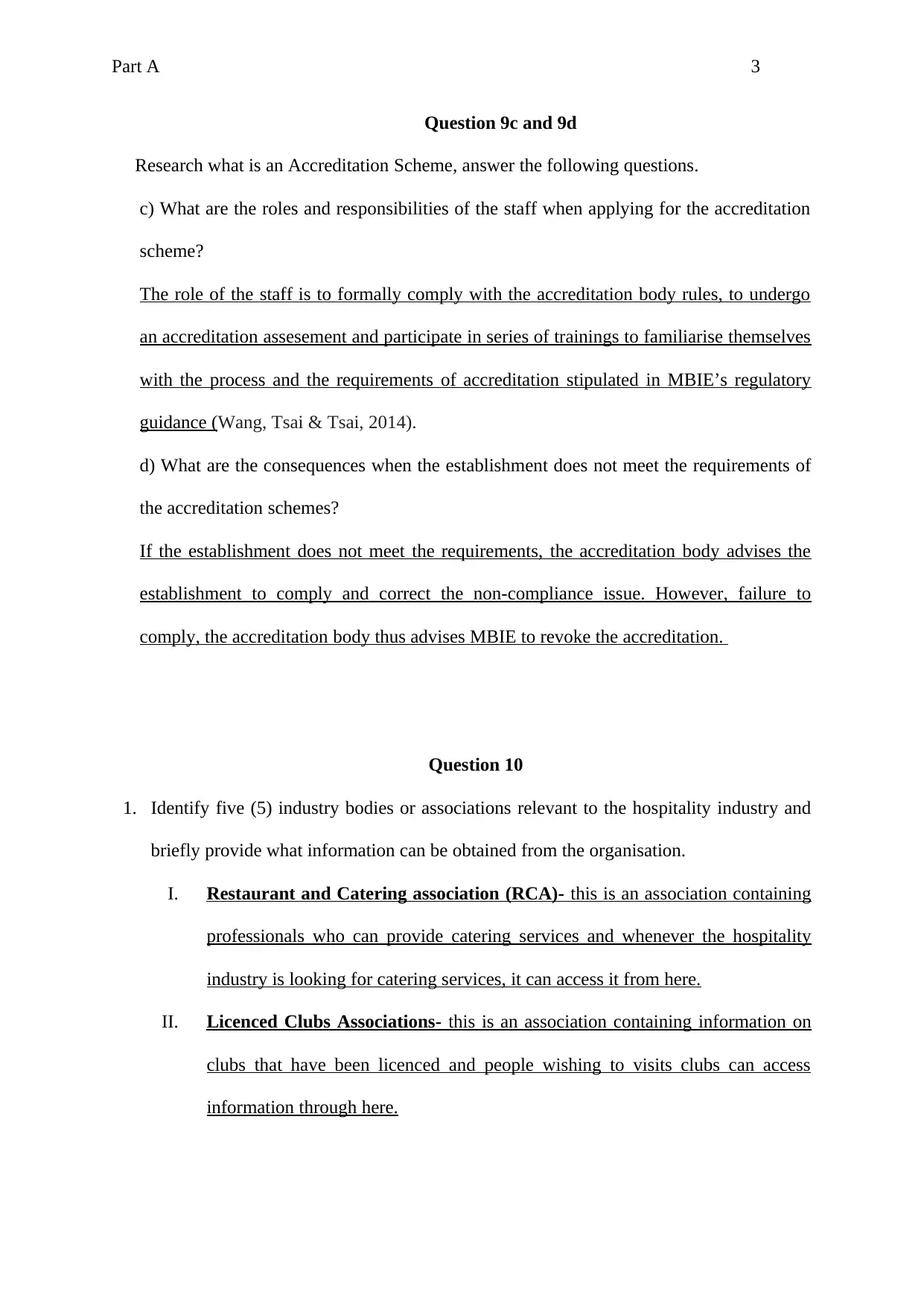
Part A 3
Question 9c and 9d
Research what is an Accreditation Scheme, answer the following questions.
c) What are the roles and responsibilities of the staff when applying for the accreditation
scheme?
The role of the staff is to formally comply with the accreditation body rules, to undergo
an accreditation assesement and participate in series of trainings to familiarise themselves
with the process and the requirements of accreditation stipulated in MBIE’s regulatory
guidance (Wang, Tsai & Tsai, 2014).
d) What are the consequences when the establishment does not meet the requirements of
the accreditation schemes?
If the establishment does not meet the requirements, the accreditation body advises the
establishment to comply and correct the non-compliance issue. However, failure to
comply, the accreditation body thus advises MBIE to revoke the accreditation.
Question 10
1. Identify five (5) industry bodies or associations relevant to the hospitality industry and
briefly provide what information can be obtained from the organisation.
I. Restaurant and Catering association (RCA)- this is an association containing
professionals who can provide catering services and whenever the hospitality
industry is looking for catering services, it can access it from here.
II. Licenced Clubs Associations- this is an association containing information on
clubs that have been licenced and people wishing to visits clubs can access
information through here.
Question 9c and 9d
Research what is an Accreditation Scheme, answer the following questions.
c) What are the roles and responsibilities of the staff when applying for the accreditation
scheme?
The role of the staff is to formally comply with the accreditation body rules, to undergo
an accreditation assesement and participate in series of trainings to familiarise themselves
with the process and the requirements of accreditation stipulated in MBIE’s regulatory
guidance (Wang, Tsai & Tsai, 2014).
d) What are the consequences when the establishment does not meet the requirements of
the accreditation schemes?
If the establishment does not meet the requirements, the accreditation body advises the
establishment to comply and correct the non-compliance issue. However, failure to
comply, the accreditation body thus advises MBIE to revoke the accreditation.
Question 10
1. Identify five (5) industry bodies or associations relevant to the hospitality industry and
briefly provide what information can be obtained from the organisation.
I. Restaurant and Catering association (RCA)- this is an association containing
professionals who can provide catering services and whenever the hospitality
industry is looking for catering services, it can access it from here.
II. Licenced Clubs Associations- this is an association containing information on
clubs that have been licenced and people wishing to visits clubs can access
information through here.
⊘ This is a preview!⊘
Do you want full access?
Subscribe today to unlock all pages.

Trusted by 1+ million students worldwide
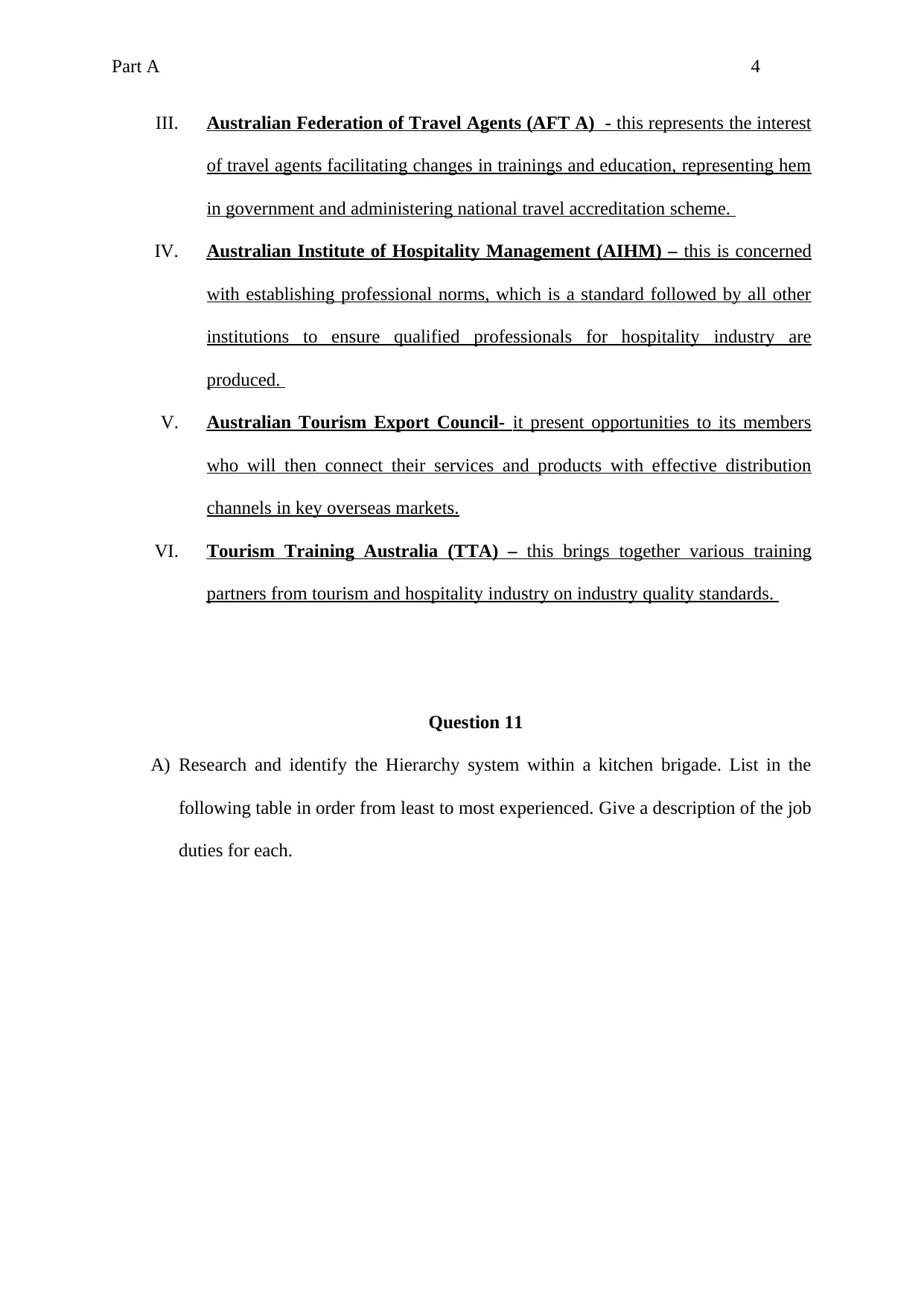
Part A 4
III. Australian Federation of Travel Agents (AFT A) - this represents the interest
of travel agents facilitating changes in trainings and education, representing hem
in government and administering national travel accreditation scheme.
IV. Australian Institute of Hospitality Management (AIHM) – this is concerned
with establishing professional norms, which is a standard followed by all other
institutions to ensure qualified professionals for hospitality industry are
produced.
V. Australian Tourism Export Council- it present opportunities to its members
who will then connect their services and products with effective distribution
channels in key overseas markets.
VI. Tourism Training Australia (TTA) – this brings together various training
partners from tourism and hospitality industry on industry quality standards.
Question 11
A) Research and identify the Hierarchy system within a kitchen brigade. List in the
following table in order from least to most experienced. Give a description of the job
duties for each.
III. Australian Federation of Travel Agents (AFT A) - this represents the interest
of travel agents facilitating changes in trainings and education, representing hem
in government and administering national travel accreditation scheme.
IV. Australian Institute of Hospitality Management (AIHM) – this is concerned
with establishing professional norms, which is a standard followed by all other
institutions to ensure qualified professionals for hospitality industry are
produced.
V. Australian Tourism Export Council- it present opportunities to its members
who will then connect their services and products with effective distribution
channels in key overseas markets.
VI. Tourism Training Australia (TTA) – this brings together various training
partners from tourism and hospitality industry on industry quality standards.
Question 11
A) Research and identify the Hierarchy system within a kitchen brigade. List in the
following table in order from least to most experienced. Give a description of the job
duties for each.
Paraphrase This Document
Need a fresh take? Get an instant paraphrase of this document with our AI Paraphraser
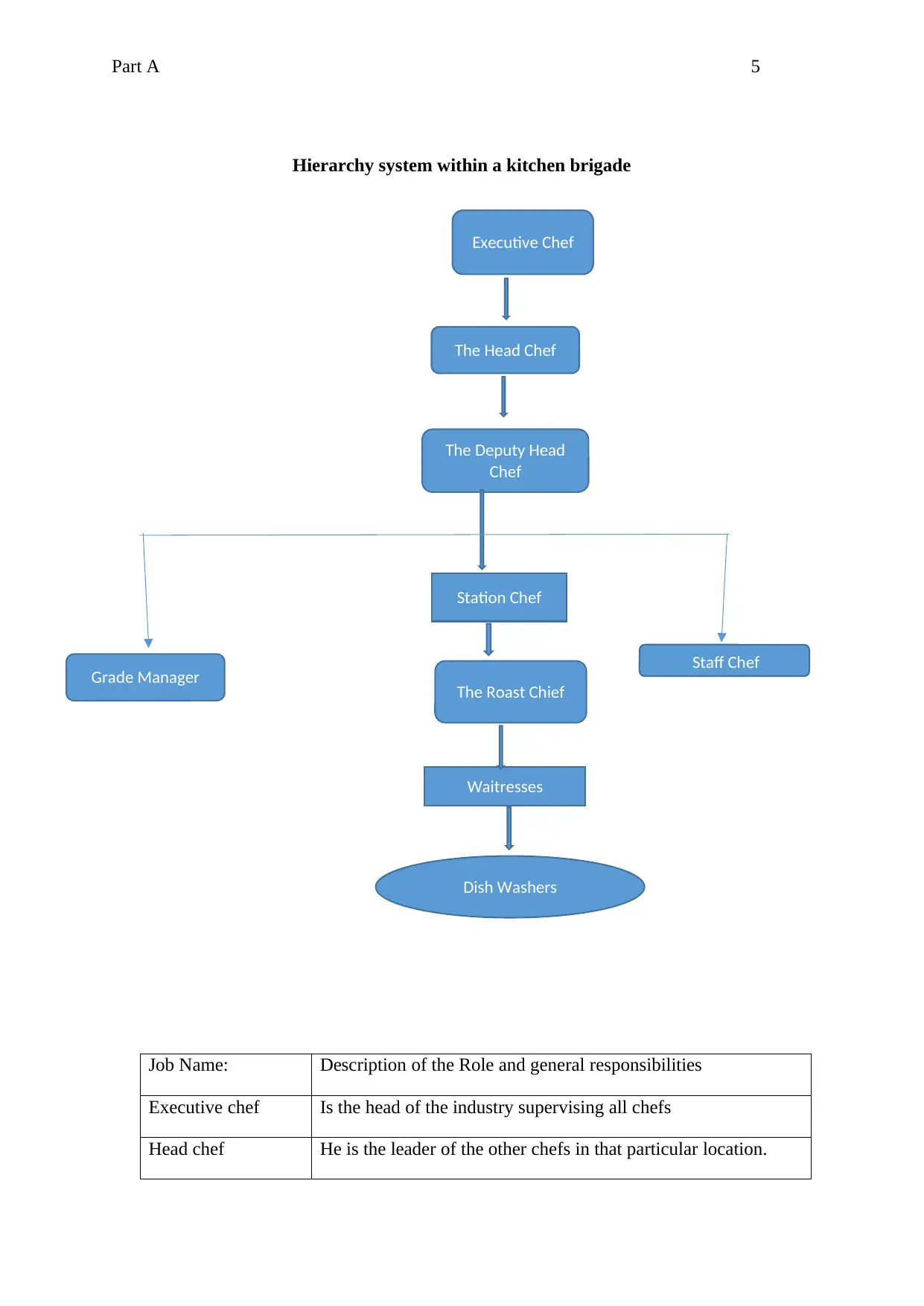
Part A 5
Hierarchy system within a kitchen brigade
Job Name: Description of the Role and general responsibilities
Executive chef Is the head of the industry supervising all chefs
Head chef He is the leader of the other chefs in that particular location.
Executive Chef
The Deputy Head
Chef
The Head Chef
Grade Manager The Roast Chief
Station Chef
Waitresses
Dish Washers
Staff Chef
Hierarchy system within a kitchen brigade
Job Name: Description of the Role and general responsibilities
Executive chef Is the head of the industry supervising all chefs
Head chef He is the leader of the other chefs in that particular location.
Executive Chef
The Deputy Head
Chef
The Head Chef
Grade Manager The Roast Chief
Station Chef
Waitresses
Dish Washers
Staff Chef
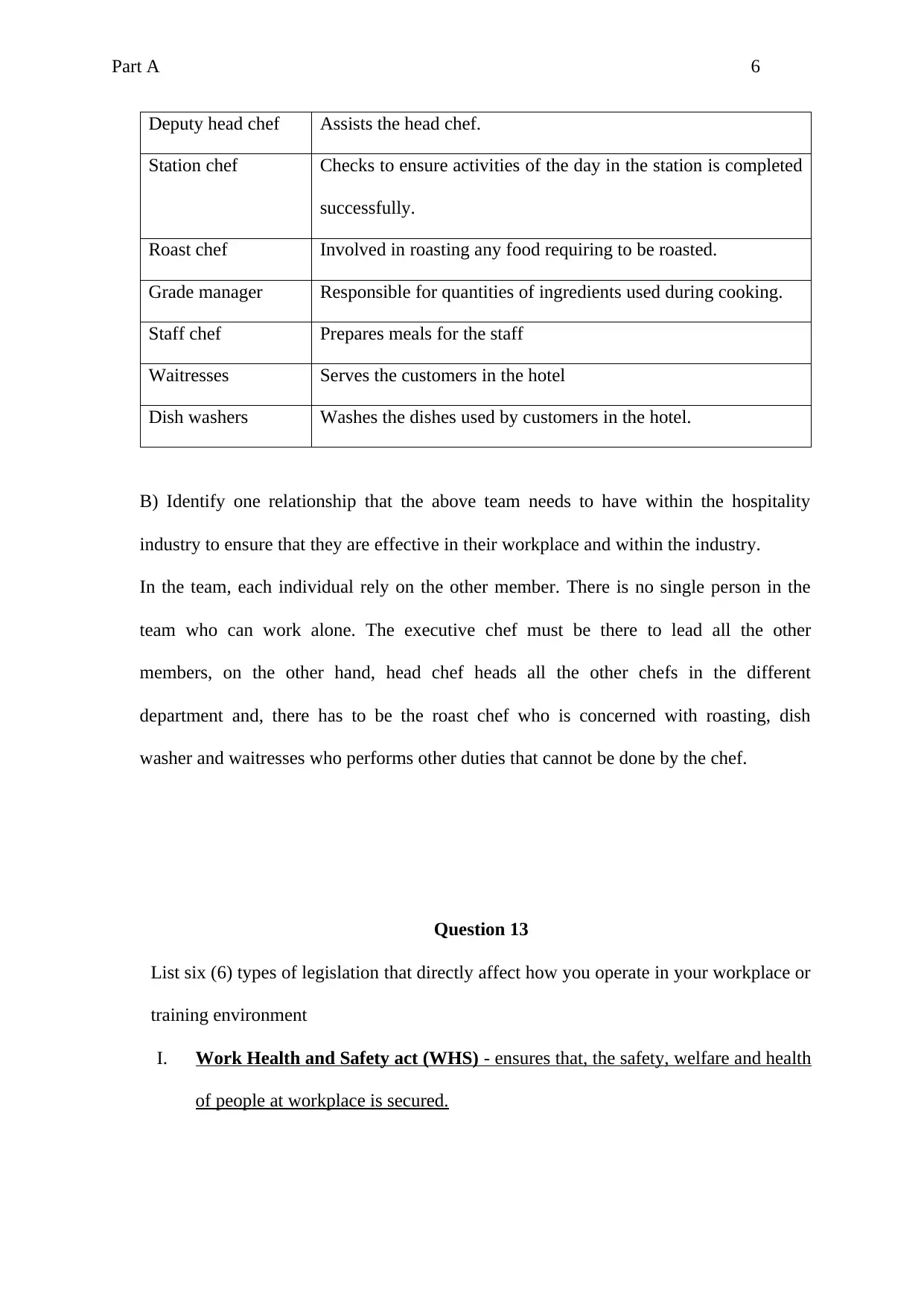
Part A 6
Deputy head chef Assists the head chef.
Station chef Checks to ensure activities of the day in the station is completed
successfully.
Roast chef Involved in roasting any food requiring to be roasted.
Grade manager Responsible for quantities of ingredients used during cooking.
Staff chef Prepares meals for the staff
Waitresses Serves the customers in the hotel
Dish washers Washes the dishes used by customers in the hotel.
B) Identify one relationship that the above team needs to have within the hospitality
industry to ensure that they are effective in their workplace and within the industry.
In the team, each individual rely on the other member. There is no single person in the
team who can work alone. The executive chef must be there to lead all the other
members, on the other hand, head chef heads all the other chefs in the different
department and, there has to be the roast chef who is concerned with roasting, dish
washer and waitresses who performs other duties that cannot be done by the chef.
Question 13
List six (6) types of legislation that directly affect how you operate in your workplace or
training environment
I. Work Health and Safety act (WHS) - ensures that, the safety, welfare and health
of people at workplace is secured.
Deputy head chef Assists the head chef.
Station chef Checks to ensure activities of the day in the station is completed
successfully.
Roast chef Involved in roasting any food requiring to be roasted.
Grade manager Responsible for quantities of ingredients used during cooking.
Staff chef Prepares meals for the staff
Waitresses Serves the customers in the hotel
Dish washers Washes the dishes used by customers in the hotel.
B) Identify one relationship that the above team needs to have within the hospitality
industry to ensure that they are effective in their workplace and within the industry.
In the team, each individual rely on the other member. There is no single person in the
team who can work alone. The executive chef must be there to lead all the other
members, on the other hand, head chef heads all the other chefs in the different
department and, there has to be the roast chef who is concerned with roasting, dish
washer and waitresses who performs other duties that cannot be done by the chef.
Question 13
List six (6) types of legislation that directly affect how you operate in your workplace or
training environment
I. Work Health and Safety act (WHS) - ensures that, the safety, welfare and health
of people at workplace is secured.
⊘ This is a preview!⊘
Do you want full access?
Subscribe today to unlock all pages.

Trusted by 1+ million students worldwide
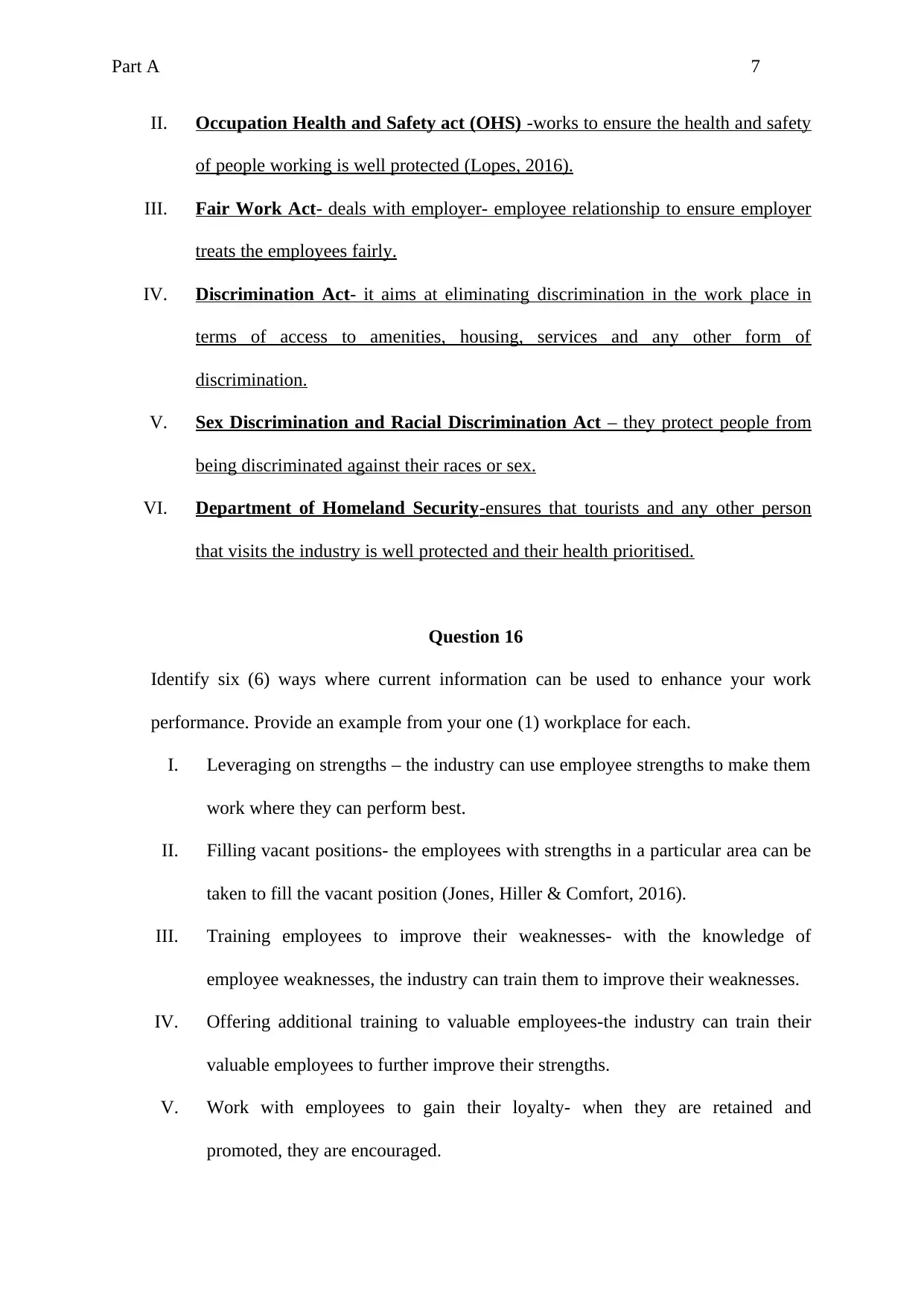
Part A 7
II. Occupation Health and Safety act (OHS) -works to ensure the health and safety
of people working is well protected (Lopes, 2016).
III. Fair Work Act- deals with employer- employee relationship to ensure employer
treats the employees fairly.
IV. Discrimination Act- it aims at eliminating discrimination in the work place in
terms of access to amenities, housing, services and any other form of
discrimination.
V. Sex Discrimination and Racial Discrimination Act – they protect people from
being discriminated against their races or sex.
VI. Department of Homeland Security-ensures that tourists and any other person
that visits the industry is well protected and their health prioritised.
Question 16
Identify six (6) ways where current information can be used to enhance your work
performance. Provide an example from your one (1) workplace for each.
I. Leveraging on strengths – the industry can use employee strengths to make them
work where they can perform best.
II. Filling vacant positions- the employees with strengths in a particular area can be
taken to fill the vacant position (Jones, Hiller & Comfort, 2016).
III. Training employees to improve their weaknesses- with the knowledge of
employee weaknesses, the industry can train them to improve their weaknesses.
IV. Offering additional training to valuable employees-the industry can train their
valuable employees to further improve their strengths.
V. Work with employees to gain their loyalty- when they are retained and
promoted, they are encouraged.
II. Occupation Health and Safety act (OHS) -works to ensure the health and safety
of people working is well protected (Lopes, 2016).
III. Fair Work Act- deals with employer- employee relationship to ensure employer
treats the employees fairly.
IV. Discrimination Act- it aims at eliminating discrimination in the work place in
terms of access to amenities, housing, services and any other form of
discrimination.
V. Sex Discrimination and Racial Discrimination Act – they protect people from
being discriminated against their races or sex.
VI. Department of Homeland Security-ensures that tourists and any other person
that visits the industry is well protected and their health prioritised.
Question 16
Identify six (6) ways where current information can be used to enhance your work
performance. Provide an example from your one (1) workplace for each.
I. Leveraging on strengths – the industry can use employee strengths to make them
work where they can perform best.
II. Filling vacant positions- the employees with strengths in a particular area can be
taken to fill the vacant position (Jones, Hiller & Comfort, 2016).
III. Training employees to improve their weaknesses- with the knowledge of
employee weaknesses, the industry can train them to improve their weaknesses.
IV. Offering additional training to valuable employees-the industry can train their
valuable employees to further improve their strengths.
V. Work with employees to gain their loyalty- when they are retained and
promoted, they are encouraged.
Paraphrase This Document
Need a fresh take? Get an instant paraphrase of this document with our AI Paraphraser
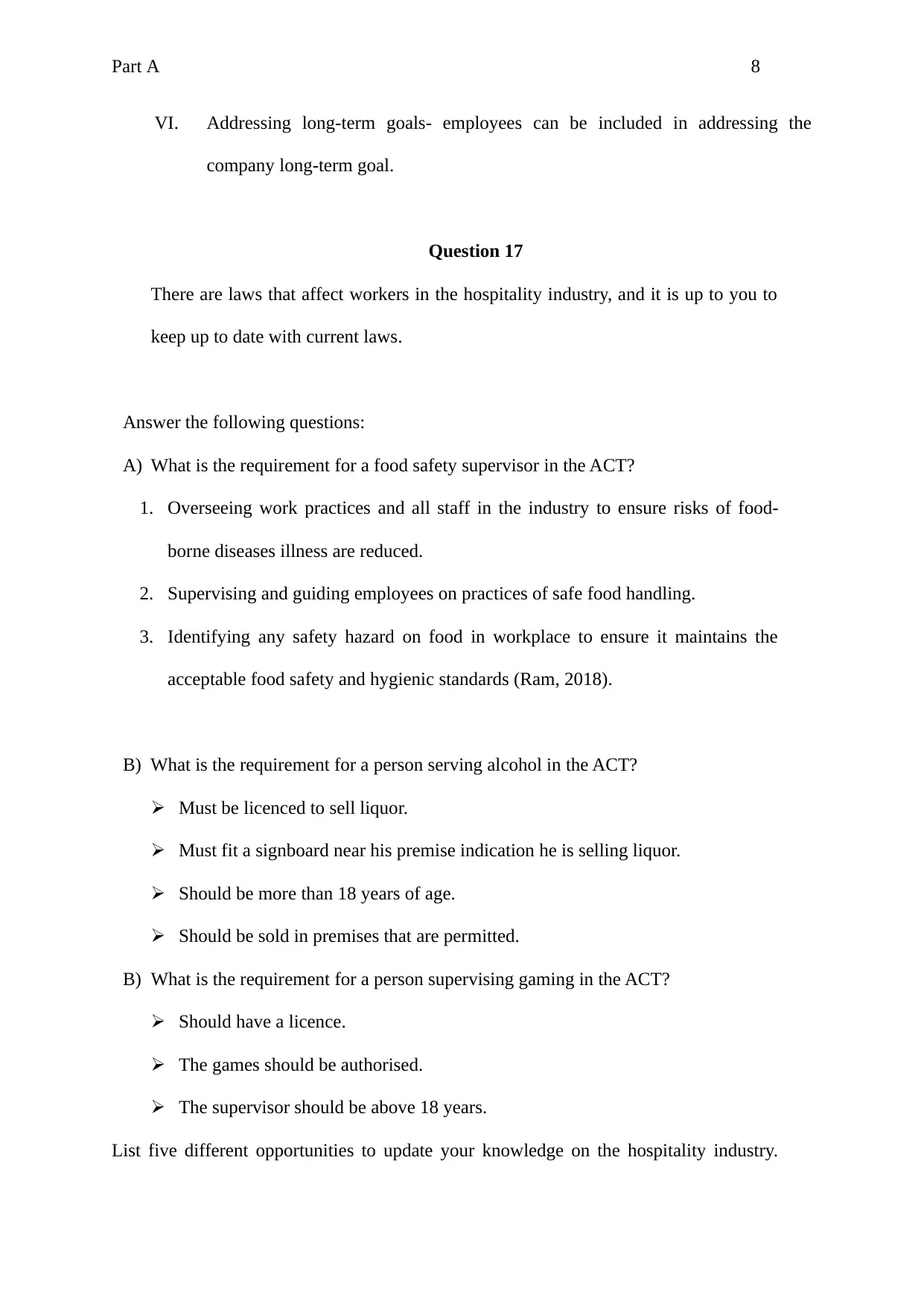
Part A 8
VI. Addressing long-term goals- employees can be included in addressing the
company long-term goal.
Question 17
There are laws that affect workers in the hospitality industry, and it is up to you to
keep up to date with current laws.
Answer the following questions:
A) What is the requirement for a food safety supervisor in the ACT?
1. Overseeing work practices and all staff in the industry to ensure risks of food-
borne diseases illness are reduced.
2. Supervising and guiding employees on practices of safe food handling.
3. Identifying any safety hazard on food in workplace to ensure it maintains the
acceptable food safety and hygienic standards (Ram, 2018).
B) What is the requirement for a person serving alcohol in the ACT?
Must be licenced to sell liquor.
Must fit a signboard near his premise indication he is selling liquor.
Should be more than 18 years of age.
Should be sold in premises that are permitted.
B) What is the requirement for a person supervising gaming in the ACT?
Should have a licence.
The games should be authorised.
The supervisor should be above 18 years.
List five different opportunities to update your knowledge on the hospitality industry.
VI. Addressing long-term goals- employees can be included in addressing the
company long-term goal.
Question 17
There are laws that affect workers in the hospitality industry, and it is up to you to
keep up to date with current laws.
Answer the following questions:
A) What is the requirement for a food safety supervisor in the ACT?
1. Overseeing work practices and all staff in the industry to ensure risks of food-
borne diseases illness are reduced.
2. Supervising and guiding employees on practices of safe food handling.
3. Identifying any safety hazard on food in workplace to ensure it maintains the
acceptable food safety and hygienic standards (Ram, 2018).
B) What is the requirement for a person serving alcohol in the ACT?
Must be licenced to sell liquor.
Must fit a signboard near his premise indication he is selling liquor.
Should be more than 18 years of age.
Should be sold in premises that are permitted.
B) What is the requirement for a person supervising gaming in the ACT?
Should have a licence.
The games should be authorised.
The supervisor should be above 18 years.
List five different opportunities to update your knowledge on the hospitality industry.
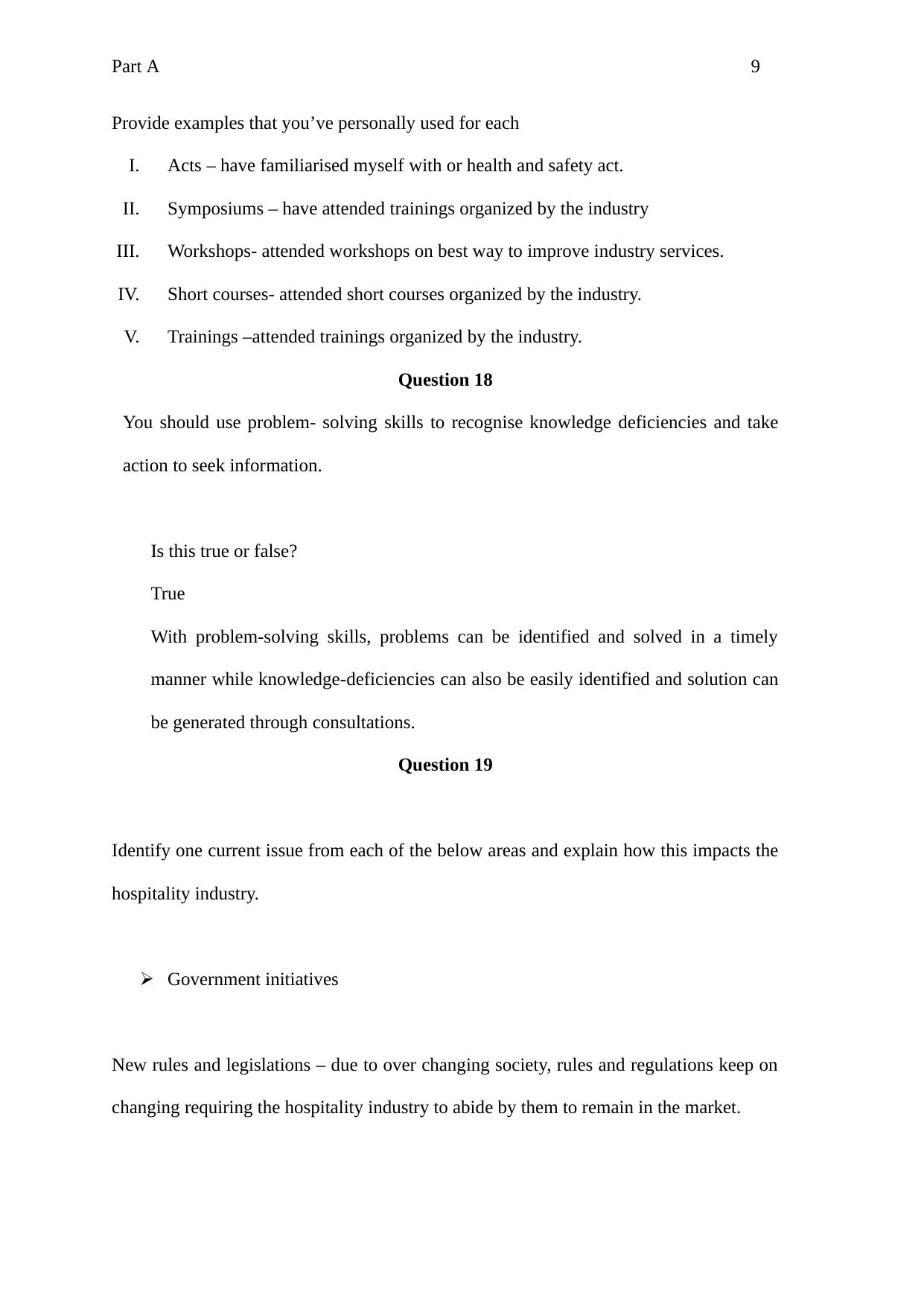
Part A 9
Provide examples that you’ve personally used for each
I. Acts – have familiarised myself with or health and safety act.
II. Symposiums – have attended trainings organized by the industry
III. Workshops- attended workshops on best way to improve industry services.
IV. Short courses- attended short courses organized by the industry.
V. Trainings –attended trainings organized by the industry.
Question 18
You should use problem- solving skills to recognise knowledge deficiencies and take
action to seek information.
Is this true or false?
True
With problem-solving skills, problems can be identified and solved in a timely
manner while knowledge-deficiencies can also be easily identified and solution can
be generated through consultations.
Question 19
Identify one current issue from each of the below areas and explain how this impacts the
hospitality industry.
Government initiatives
New rules and legislations – due to over changing society, rules and regulations keep on
changing requiring the hospitality industry to abide by them to remain in the market.
Provide examples that you’ve personally used for each
I. Acts – have familiarised myself with or health and safety act.
II. Symposiums – have attended trainings organized by the industry
III. Workshops- attended workshops on best way to improve industry services.
IV. Short courses- attended short courses organized by the industry.
V. Trainings –attended trainings organized by the industry.
Question 18
You should use problem- solving skills to recognise knowledge deficiencies and take
action to seek information.
Is this true or false?
True
With problem-solving skills, problems can be identified and solved in a timely
manner while knowledge-deficiencies can also be easily identified and solution can
be generated through consultations.
Question 19
Identify one current issue from each of the below areas and explain how this impacts the
hospitality industry.
Government initiatives
New rules and legislations – due to over changing society, rules and regulations keep on
changing requiring the hospitality industry to abide by them to remain in the market.
⊘ This is a preview!⊘
Do you want full access?
Subscribe today to unlock all pages.

Trusted by 1+ million students worldwide
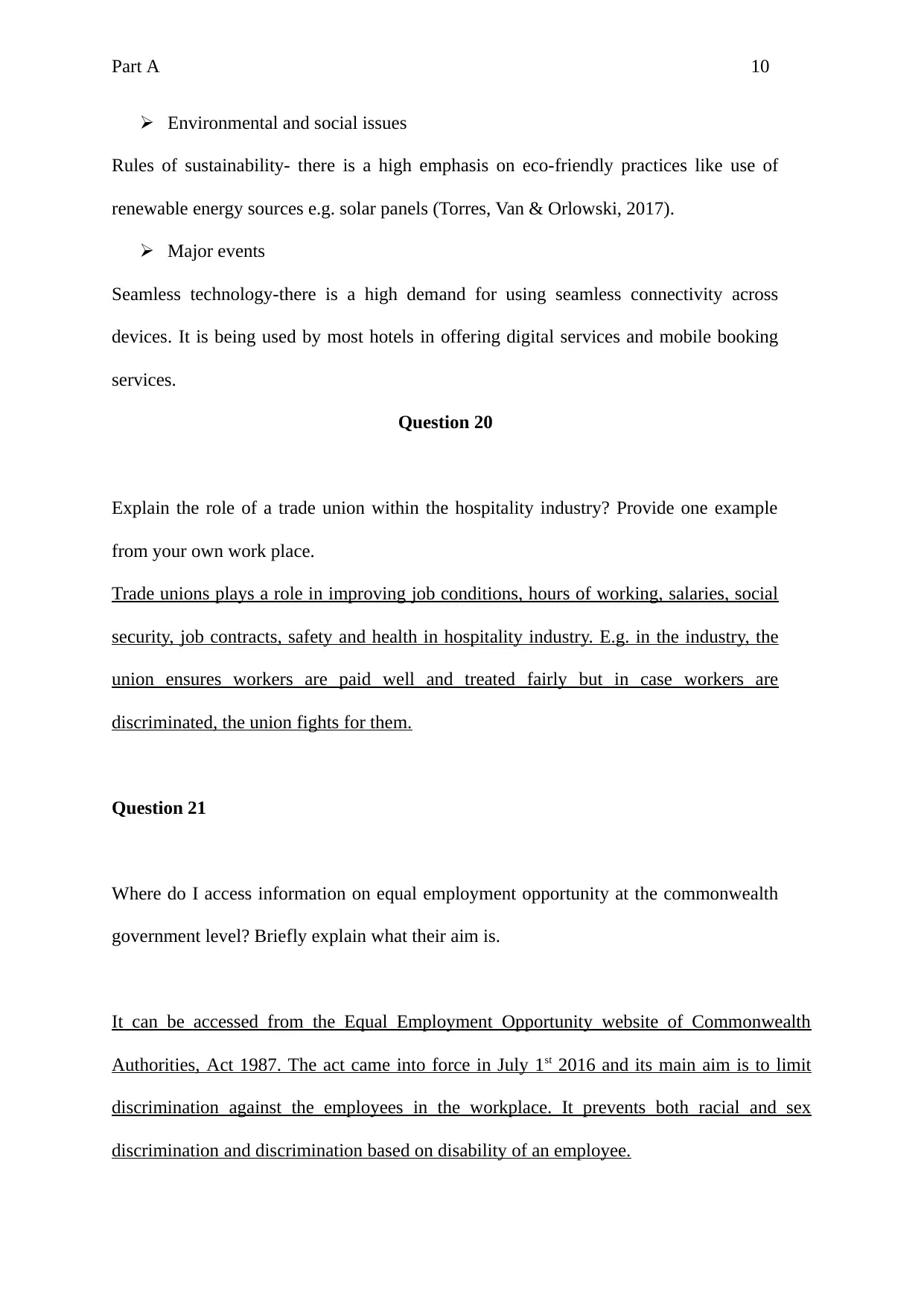
Part A 10
Environmental and social issues
Rules of sustainability- there is a high emphasis on eco-friendly practices like use of
renewable energy sources e.g. solar panels (Torres, Van & Orlowski, 2017).
Major events
Seamless technology-there is a high demand for using seamless connectivity across
devices. It is being used by most hotels in offering digital services and mobile booking
services.
Question 20
Explain the role of a trade union within the hospitality industry? Provide one example
from your own work place.
Trade unions plays a role in improving job conditions, hours of working, salaries, social
security, job contracts, safety and health in hospitality industry. E.g. in the industry, the
union ensures workers are paid well and treated fairly but in case workers are
discriminated, the union fights for them.
Question 21
Where do I access information on equal employment opportunity at the commonwealth
government level? Briefly explain what their aim is.
It can be accessed from the Equal Employment Opportunity website of Commonwealth
Authorities, Act 1987. The act came into force in July 1st 2016 and its main aim is to limit
discrimination against the employees in the workplace. It prevents both racial and sex
discrimination and discrimination based on disability of an employee.
Environmental and social issues
Rules of sustainability- there is a high emphasis on eco-friendly practices like use of
renewable energy sources e.g. solar panels (Torres, Van & Orlowski, 2017).
Major events
Seamless technology-there is a high demand for using seamless connectivity across
devices. It is being used by most hotels in offering digital services and mobile booking
services.
Question 20
Explain the role of a trade union within the hospitality industry? Provide one example
from your own work place.
Trade unions plays a role in improving job conditions, hours of working, salaries, social
security, job contracts, safety and health in hospitality industry. E.g. in the industry, the
union ensures workers are paid well and treated fairly but in case workers are
discriminated, the union fights for them.
Question 21
Where do I access information on equal employment opportunity at the commonwealth
government level? Briefly explain what their aim is.
It can be accessed from the Equal Employment Opportunity website of Commonwealth
Authorities, Act 1987. The act came into force in July 1st 2016 and its main aim is to limit
discrimination against the employees in the workplace. It prevents both racial and sex
discrimination and discrimination based on disability of an employee.
Paraphrase This Document
Need a fresh take? Get an instant paraphrase of this document with our AI Paraphraser
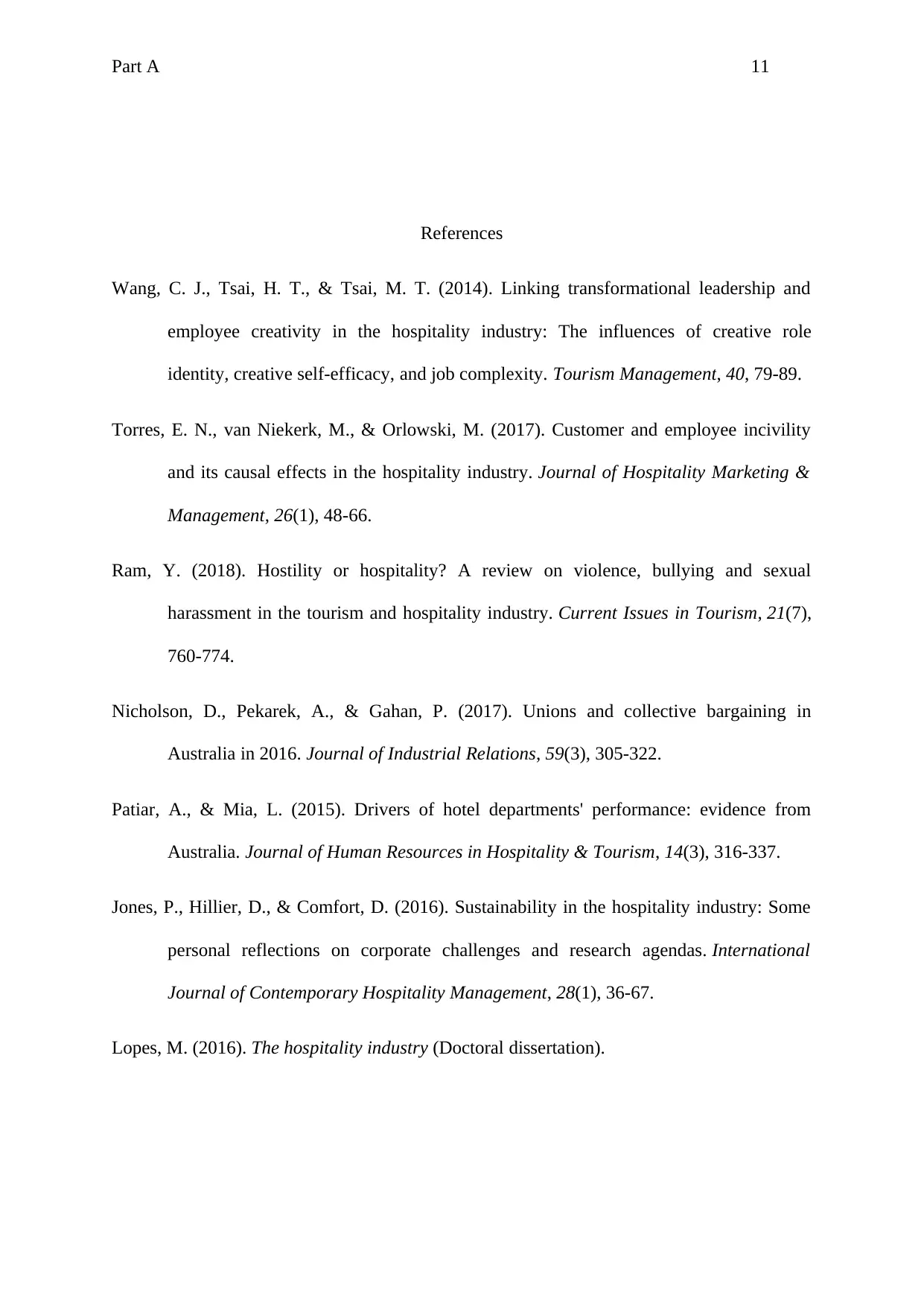
Part A 11
References
Wang, C. J., Tsai, H. T., & Tsai, M. T. (2014). Linking transformational leadership and
employee creativity in the hospitality industry: The influences of creative role
identity, creative self-efficacy, and job complexity. Tourism Management, 40, 79-89.
Torres, E. N., van Niekerk, M., & Orlowski, M. (2017). Customer and employee incivility
and its causal effects in the hospitality industry. Journal of Hospitality Marketing &
Management, 26(1), 48-66.
Ram, Y. (2018). Hostility or hospitality? A review on violence, bullying and sexual
harassment in the tourism and hospitality industry. Current Issues in Tourism, 21(7),
760-774.
Nicholson, D., Pekarek, A., & Gahan, P. (2017). Unions and collective bargaining in
Australia in 2016. Journal of Industrial Relations, 59(3), 305-322.
Patiar, A., & Mia, L. (2015). Drivers of hotel departments' performance: evidence from
Australia. Journal of Human Resources in Hospitality & Tourism, 14(3), 316-337.
Jones, P., Hillier, D., & Comfort, D. (2016). Sustainability in the hospitality industry: Some
personal reflections on corporate challenges and research agendas. International
Journal of Contemporary Hospitality Management, 28(1), 36-67.
Lopes, M. (2016). The hospitality industry (Doctoral dissertation).
References
Wang, C. J., Tsai, H. T., & Tsai, M. T. (2014). Linking transformational leadership and
employee creativity in the hospitality industry: The influences of creative role
identity, creative self-efficacy, and job complexity. Tourism Management, 40, 79-89.
Torres, E. N., van Niekerk, M., & Orlowski, M. (2017). Customer and employee incivility
and its causal effects in the hospitality industry. Journal of Hospitality Marketing &
Management, 26(1), 48-66.
Ram, Y. (2018). Hostility or hospitality? A review on violence, bullying and sexual
harassment in the tourism and hospitality industry. Current Issues in Tourism, 21(7),
760-774.
Nicholson, D., Pekarek, A., & Gahan, P. (2017). Unions and collective bargaining in
Australia in 2016. Journal of Industrial Relations, 59(3), 305-322.
Patiar, A., & Mia, L. (2015). Drivers of hotel departments' performance: evidence from
Australia. Journal of Human Resources in Hospitality & Tourism, 14(3), 316-337.
Jones, P., Hillier, D., & Comfort, D. (2016). Sustainability in the hospitality industry: Some
personal reflections on corporate challenges and research agendas. International
Journal of Contemporary Hospitality Management, 28(1), 36-67.
Lopes, M. (2016). The hospitality industry (Doctoral dissertation).
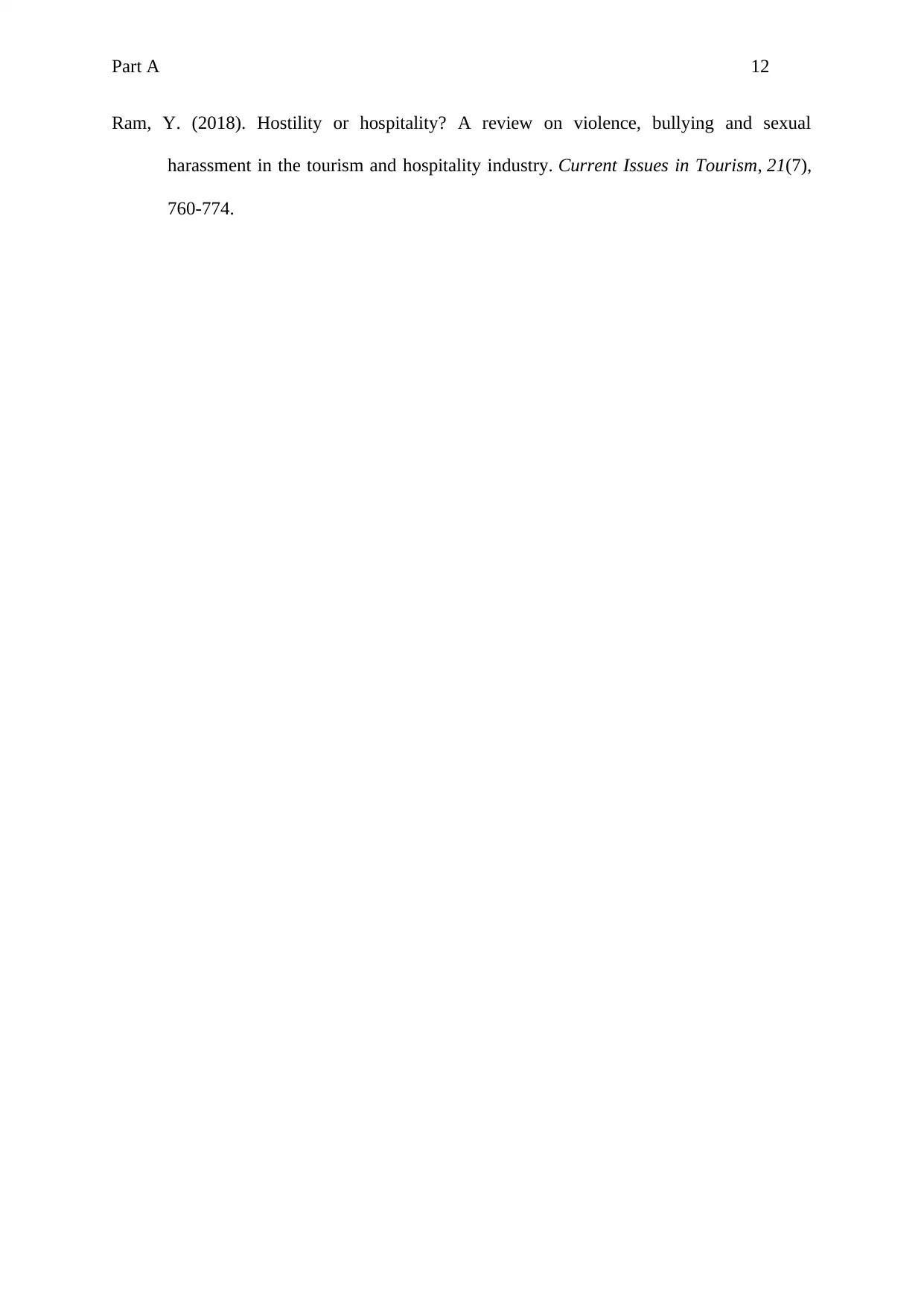
Part A 12
Ram, Y. (2018). Hostility or hospitality? A review on violence, bullying and sexual
harassment in the tourism and hospitality industry. Current Issues in Tourism, 21(7),
760-774.
Ram, Y. (2018). Hostility or hospitality? A review on violence, bullying and sexual
harassment in the tourism and hospitality industry. Current Issues in Tourism, 21(7),
760-774.
⊘ This is a preview!⊘
Do you want full access?
Subscribe today to unlock all pages.

Trusted by 1+ million students worldwide
1 out of 12
Your All-in-One AI-Powered Toolkit for Academic Success.
+13062052269
info@desklib.com
Available 24*7 on WhatsApp / Email
![[object Object]](/_next/static/media/star-bottom.7253800d.svg)
Unlock your academic potential
Copyright © 2020–2025 A2Z Services. All Rights Reserved. Developed and managed by ZUCOL.